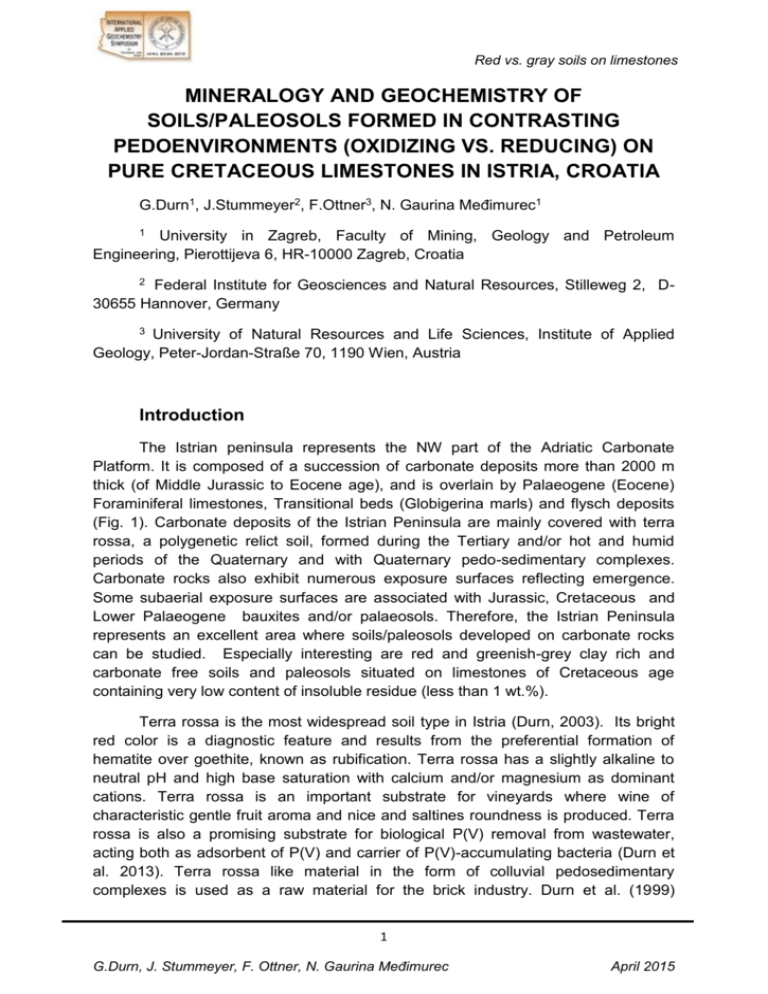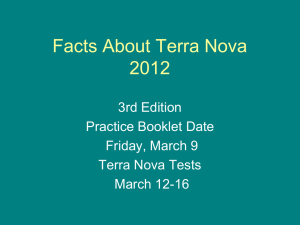Mineralogy and geochemistry of soils/paleosols formed in
advertisement

Red vs. gray soils on limestones MINERALOGY AND GEOCHEMISTRY OF SOILS/PALEOSOLS FORMED IN CONTRASTING PEDOENVIRONMENTS (OXIDIZING VS. REDUCING) ON PURE CRETACEOUS LIMESTONES IN ISTRIA, CROATIA G.Durn1, J.Stummeyer2, F.Ottner3, N. Gaurina Međimurec1 1 University in Zagreb, Faculty of Mining, Geology and Petroleum Engineering, Pierottijeva 6, HR-10000 Zagreb, Croatia 2 Federal Institute for Geosciences and Natural Resources, Stilleweg 2, D30655 Hannover, Germany 3 University of Natural Resources and Life Sciences, Institute of Applied Geology, Peter-Jordan-Straße 70, 1190 Wien, Austria Introduction The Istrian peninsula represents the NW part of the Adriatic Carbonate Platform. It is composed of a succession of carbonate deposits more than 2000 m thick (of Middle Jurassic to Eocene age), and is overlain by Palaeogene (Eocene) Foraminiferal limestones, Transitional beds (Globigerina marls) and flysch deposits (Fig. 1). Carbonate deposits of the Istrian Peninsula are mainly covered with terra rossa, a polygenetic relict soil, formed during the Tertiary and/or hot and humid periods of the Quaternary and with Quaternary pedo-sedimentary complexes. Carbonate rocks also exhibit numerous exposure surfaces reflecting emergence. Some subaerial exposure surfaces are associated with Jurassic, Cretaceous and Lower Palaeogene bauxites and/or palaeosols. Therefore, the Istrian Peninsula represents an excellent area where soils/paleosols developed on carbonate rocks can be studied. Especially interesting are red and greenish-grey clay rich and carbonate free soils and paleosols situated on limestones of Cretaceous age containing very low content of insoluble residue (less than 1 wt.%). Terra rossa is the most widespread soil type in Istria (Durn, 2003). Its bright red color is a diagnostic feature and results from the preferential formation of hematite over goethite, known as rubification. Terra rossa has a slightly alkaline to neutral pH and high base saturation with calcium and/or magnesium as dominant cations. Terra rossa is an important substrate for vineyards where wine of characteristic gentle fruit aroma and nice and saltines roundness is produced. Terra rossa is also a promising substrate for biological P(V) removal from wastewater, acting both as adsorbent of P(V) and carrier of P(V)-accumulating bacteria (Durn et al. 2013). Terra rossa like material in the form of colluvial pedosedimentary complexes is used as a raw material for the brick industry. Durn et al. (1999) 1 G.Durn, J. Stummeyer, F. Ottner, N. Gaurina Međimurec April 2015 Red vs. gray soils on limestones presented evidence for the polygenetic nature of terra rossa in Istria, based on detailed mineralogical and geochemical investigations. Durn et al. (2007) found that the most likely additional flux to the insoluble residue of limestone influencing terra rossa formation in Istria is aeolian dust, followed by flysch sediments and, sporadically, bauxites and their contribution might have been up to 50%. Greenish-gray clays within Lower Cretaceous shallow-water carbonates in Western Istria are associated with several emersions (e.g. Late Barremian emergence and Late Aptian–Late Albian regional emergence), show clear evidence of subaerial exposure and are considered paleosols. Mineralogical, geochemical and micromorphological investigations showed that those Lower Creataceous paleosols were probably seasonally marshy soils or permanently waterlogged soils of polygenetic origin (Ottner et al. 1999; Durn et al. 2006). Our current research shows that the most likely additional flux to the insoluble residue of limestone influencing formation of greenish-gray paleosols are aeolian and volcanic dust. In paleosol associated with Late Aptian–Late Albian regional emergence in the Tri Jezerca quarry, Hrenović et al. (2014) reported an incidental finding of viable clinically related multi-drug resistant strain of Acinetobacter baumannii in abundance of 80-120 CFU/g. In the paleosol, A. baumannii is immobilized on soil particles. The environmental isolate of A. baumannii showed similarity with a clinical isolate originating from hospital in this geographic area and was resistant to gentamicin, trimethoprim/sulfamethoxazole, ciprofloxacin and levofloxacin (Hrenović et al. 2014).. Figure 1. (A) Position of Croatia in Europe. (B) Simplified geological map of Istria 1. Upper Jurassic (limestones and dolomites). 2. Cretaceous (limestones and dolomites). 3. Paleocene–Eocene (mainly limestones). 4. Eocene (flysch). 5. Quaternary (loess). 6. Faults (normal and reverse). 2 G.Durn, J. Stummeyer, F. Ottner, N. Gaurina Međimurec April 2015 Red vs. gray soils on limestones The aim of the present contribution is to compare mineral and chemical composition as well as to assess the mobility of selected elements in two types of polygenetic clayey soils/paleosols that formed in contrasting pedoenvironments (oxidizing vs. reducing) on pure limestones of Cretaceous age. Methodology Six terra rossa samples (2.5YR to 10R in Munsell Hue) and five Cretaceous paleosol samples (5BG to 10BG in Munsell Hue) from B horizons on limestones of Cretaceous age were taken at 8 localities in Istria and air-dried afterwards (Fig .2). A portion of each disturbed soil/paleosol sample was gently crushed and sieved through a 2 mm sieve for mineralogical and chemical analyses. The mineral composition of bulk sample and <2μm fraction was determined by X-ray powder diffraction (XRD) using a Philips diffractometer (graphite monochromator, CuKα radiation, proportional counter). The XRD patterns of bulk sample and non-oriented <2μm fraction were taken after air-drying. The XRD patterns of oriented <2μm fraction were taken after the following treatments: (a) Mg-saturation, (b) K-saturation, (c) Mg-saturation and ethylene glycol solvation, (d) Mg-saturation and glycerol solvation, (e) K-saturation and DMSO solvation, and (f) heating for two hours at 550°C. The identification of clay minerals was generally based on the methods outlined by Brown (1961), Brindley & Brown (1980), and Moore & Reynolds (1989). By means of semiquantitative XRD analysis the amounts of quartz, plagioclase, Kfeldspar, boehmite, pyrite, and gypsum were determined in selected bulk samples. An external standard was applied, by measuring relative intensities of characteristic diffraction lines. Estimation of iron oxide percentages was based on the content of iron extractable with Na dithionite–citrate bicarbonate. Semi-quantitative estimates of clay minerals in the < 2 μm fraction were based on the relative intensities of characteristic X-ray peaks following the method of Johns et al. (1954). Estimated quantities of minerals were presented with Xs, but no quantitative value was assigned to each X. The contents of major and trace elements (including REEs) in bulk samples (fraction < 2mm) were determined with XRF and ICP-MS respectively. The samples were also extracted according to a five-step sequential-extraction procedure following Tessier et al. (1979). Sequential extraction was performed to give the following five fractions: adsorbed (I), bound to carbonates (II), bound to iron and manganese oxides (III), bound to organic matter and sulphides (IV) and residual (V). The residual fraction (V) was calculated as the difference between the total content of particular element and sum of the first four fractions (I to IV). After leaching the samples, As, Ba, Cd, Co, Cr, Cu, Fe, Mn, Mo, Ni, Pb, Sb, V and Zn were determined with ICP- OES. Following that, REEs from the leaching solutions were analyzed at trace levels (after dilution) with ICP- MS. 3 G.Durn, J. Stummeyer, F. Ottner, N. Gaurina Međimurec April 2015 Red vs. gray soils on limestones Figure 2. Terra rossa soil in Novigrad (left) and greenish-gray paleosol in Seline (Tri Jezerca quarry). Results Terra rossa soils are clays and silty clays composed of quartz, plagioclase, Kfeldspar, micaceous clay minerals (illitic material and mica), kaolinites (Kl d and Kl), chlorite, vermiculite, mixed layer clay minerals, hematite and goethite (Tab. 1). Lowcharge-vermiculite or high-charge smectite and boehmite are sporadically present and are of local importance. Kaolinites and illitic material are dominant clay mineral phases in the clay fraction of terra rossa. Greenish-gray paleosols (GGP) are clays composed of phyllosilicates and pyrite. Only in one sample secondary mineral gypsum was detected (Tab. 1). The main clay mineral phases are illitic material and ordered and irregularly oriented illite/smectite mixed layer minerals. Chlorite was detected in two samples (Tab. 1). Terra rossa soils are enriched in SiO2, Fe2O3, MnO, Na2O and P2O5 compared with the GGP which are, compared with the terra rossa soils, enriched in K2O, MgO and SO3 (Tab. 2). GGP are enriched in Cd, Sb, Ni, V and especially in U and Mo compared with the terra rossa soils which are, compared to GGP, slightly enriched in Co and Pb and significantly enriched in REE (Figs. 3 and 4). The total REE content ranges from 199.89 to 500.69 ppm in terra rossa and from 93.64 to 126.33 ppm in GGP. REE patterns (mean values of 6 terra rossa samples and mean values of 5 GGP samples ± standard deviation) of terra rossa and GGP normalized to upper continental crust are shown on Fig. 4. (La/Yb) ch ratios in terra rossa ranges from 9.73 to 12.06 and are higher than that of upper continental crust (9.21) indicating LREE enrichment relative to HREE. On the contrary, (La/Yb)ch ratios in GGP ranges from 5.14 to 7.59 and are significantly lower than that of upper continental crust indicating HREE enrichment relative to LREE. 4 G.Durn, J. Stummeyer, F. Ottner, N. Gaurina Međimurec April 2015 Red vs. gray soils on limestones Table 1. Semi-quantitative mineral composition of the < 2mm fraction of the investigated soil/paleosol samples based on the analysis of <2mm and <2μm fractions Sample TR 1 TR 2 TR 3 TR 4 TR 5 TR 6 CP 1 CP 2 CP 3 CP 4 CP 5 Q 29 31 25 14 23 16 Pl 1 1 1 2 2 1 Kf 1 1 1 1 1 HG 5 6 7 8 6 7 B Py G M+Ill* xx xx xx xx xx xx MLIS 1 1 2 2 2 xxx xx xx xxx xxx x xx xx x x 10 Kl xxx xxx xxx xxx xxx xxx V x x x x x x C x x x x x x LcV x MC x x x x x x x x TR: Terra rossa, CP: Cretaceous paleosol, Q: Quartz, Pl: Plagioclase, Kf: Kfeldspar, HG: Hematite + Goethite, B: Boehmite, Py: Pyrite, G: Gypsum, M+III*: Mica + Illitic material (in Cretaceous paleosol mica is not present), MLIS: Mixed-layer illitesmectite, Kl: Kaolinite, V: Vermiculite, C: Chlorite, LcV: Low charged vermiculite, MC: Mixed-layer clay mineral (other than MLIS), x: relative abundance of clay minerals within horizons based on x-ray diffraction (no quantitative value is assigned to x). The results of the sequential extraction analysis of terra rossa soils and GGP are presented on Figs. 5, 6, 7 and 8. The elements on Figs. 5 and 6 are shown (from left to right) based on the increasing amount of the residual fraction (V) in their total content (total content is 100%, i.e. 1 on Figs. 5 and 6). Terra rossa samples differ in partitioning in comparison with GGP. Mn, Co and Pb are considered most mobile in terra rossa (< 50% of total content is in residual fraction), while Cd, Ni, Co and Zn are considered most mobile in GGP (< 50% of total content is in residual fraction). Most immobile elements (> 80% in residual fraction) in terra rossa are Cu, V, Zn, Cr, Ni, As and Mo (Fig. 5) and in GPP are Mn, Sb, As, V, Ba and Cr (Figs. 5 and 6). Compared to terra rossa soils where residual (V), reducible (III) and oxidizable (IV) fractions compete as the sink for REE (Fig. 7), predominant sink for REE in GGP is residual fraction, followed by oxidizable fraction (Fig. 8). 5 G.Durn, J. Stummeyer, F. Ottner, N. Gaurina Međimurec April 2015 Red vs. gray soils on limestones Table 2. Chemical composition of the < 2mm fraction of the investigated soil/paleosol samples Sample SiO2 TiO2 Al2O3 Fe2O3 MnO MgO CaO Na2O P2O5 SO3 LOI TR 1 59,72 0,937 17,74 7,24 0,040 0,84 0,981 0,45 0,066 0,050 10,12 TR 2 52,47 0,956 22,04 8,36 0,146 0,73 0,631 0,50 0,100 0,005 12,00 TR 3 57,34 1,031 18,74 6,82 0,116 0,69 0,909 0,71 0,105 0,020 11,47 TR 4 42,33 1,105 28,92 10,22 0,079 0,68 0,316 0,18 0,130 0,020 14,51 TR 5 51,57 0,941 22,34 8,40 0,086 0,68 0,726 0,52 0,089 0,005 12,75 TR 6 52,10 0,976 22,13 8,42 0,099 0,68 0,665 0,45 0,097 0,005 12,46 CP 1 44,77 1,243 22,87 5,10 0,008 2,42 1,386 0,19 0,016 2,17 14,58 CP 2 48,88 1,119 24,84 2,67 0,007 2,64 1,088 0,18 0,013 0,22 14,21 CP 3 46,28 1,195 22,53 4,85 0,007 2,67 0,469 0,18 0,014 1,36 15,97 CP 4 46,54 1,184 24,65 4,28 0,018 2,76 0,170 0,10 0,025 0,74 14,22 CP 5 48,14 1,310 23,37 4,67 0,011 2,89 1,115 0,17 0,025 0,01 12,41 6 G.Durn, J. Stummeyer, F. Ottner, N. Gaurina Međimurec April 2015 Red vs. gray soils on limestones Figure 3. Distribution of trace elements in terra rossa soils and greenishgray paleosols. Figure 4. Distribution of REE in terra rossa soils and greenish-gray paleosols. 7 G.Durn, J. Stummeyer, F. Ottner, N. Gaurina Međimurec April 2015 Red vs. gray soils on limestones Figure 5. Distribution of analyzed elements in sequential fractions of terra rossa soils (mean values of 6 samples). I: adsorbed, II: bound to carbonate, III: bound to iron and manganese oxides, IV: bound to organic matter and sulphides and V: residual fraction. Figure 6. Distribution of analyzed elements in sequential fractions of greenishgray paleosols (mean values of 5 samples). I: adsorbed, II: bound to carbonate, III: bound to iron and manganese oxides, IV: bound to organic matter and sulphides and V: residual fraction. 8 G.Durn, J. Stummeyer, F. Ottner, N. Gaurina Međimurec April 2015 Red vs. gray soils on limestones Figure 7. Distribution of REE in sequential fractions of terra rossa soils (mean values of 6 samples). I: adsorbed, II: bound to carbonate, III: bound to iron and manganese oxides, IV: bound to organic matter and sulphides and V: residual fraction. Figure 8. Distribution of REE in sequential fractions of greenish-gray paleosols samples (mean values of 5 samples). I: adsorbed, II: bound to carbonate, III: bound to iron and manganese oxides, IV: bound to organic matter and sulphides and V: residual fraction. 9 G.Durn, J. Stummeyer, F. Ottner, N. Gaurina Međimurec April 2015 Red vs. gray soils on limestones Discussion & Conclusions The main difference between terra rossa soils and GGP observed in the field is their color which indicates that, generally, terra rossa soils formed in oxidizing while GGP formed in reducing pedoenvironment. Our investigation showed that mineral data corresponds well with chemical data of those soils/paleosols. Higher SiO2 and Na2O in terra rossa soils compared to GGP is the result of quartz and plagioclase, mineral phases that were not detected in GGP. Higher Fe 2O3 in terra rossa soils is the result of hematite and goethite formation, mineral phases that are specific for the oxidizing, well drained and slightly alkaline to neutral pH pedoenvironment in which terra rossa is formed (Boero and Schwertmann, 1989; Durn et al., 2007). The values obtained for P2O5 and MnO in terra rossa match that finding well. Namely, Durn et al. (2001) found that the mean value of the Mn d /Mnt ratio in Istrian terra rossa is 0.74 and indicates that most of the manganese in terra rossa is in the form of Mn oxides and hydroxides. Compared to GPP, terra rossa soils are slightly enriched in Co and Pb and significantly enriched in REE. The important difference in the total REE in analyzed terra rossa soils can be attributed to the REE content of both parent carbonate rocks (their insoluble residues) and different external materials which have contributed in the genesis of terra rossa (loess, flysch, bauxite), modified by weathering processes which characterize specific pedoenvironment in which terra rossa is formed and which favors LREE enrichment. Sequential extraction analysis showed that Mn, Co and Pb, mainly bound to reducible fraction (III), are the most mobile trace elements in terra rossa, while the most available are Cd, Ba, Sb and As, bound to adsorbed fraction (I). The following fractions (non-residual content) were found to be the major sinks for the metals in terra rossa (in order of decreasing concentration): Cd, Ba, Sb, As Fe, Cu, Zn, Ni, Pb, Zn Mn, Co V, Mo I > II/III/IV III > IV> II/I III > II >IV/I IV > III/II/I Mobility of Co, Pb and especially Mn, elements enriched in terra rossa soils is higher in terra rossa soils than in GGP showing that formation of Mn oxides might have played important role in their accumulation in terra rossa soils. Partitioning of REE in sequential fractions of terra rossa soils showed that authigenic Fe-oxides and/or Mn oxides are probably important sink for REE. K2O contents in GGP clearly indicate that illitic material is the dominant mineral phase in the GGP. Ottner et al. (1999) found that the smectites in illite/smectite mixed-layer minerals from clays in the Tri Jezerca quarry are aluminum rich montmorillonites without iron substitution in the octahedral position. The values obtained for MgO in GGP match that finding well. Higher SO 3 in GGP is the result of 10 G.Durn, J. Stummeyer, F. Ottner, N. Gaurina Međimurec April 2015 Red vs. gray soils on limestones pyrite and gypsum formation, mineral phases that were not detected in terra rossa soils. Pyrite indicates acidic and reductive pedogenic paleoenvironment of GGP formation. (Sub)recent pyrite oxidation at the surface results in the formation of the secondary mineral gypsum. The enrichment of GGP in Cd, Sb, Ni, V and especially in U and Mo is considered typical for reducing environments. Variation of the total REE content in GGP is much narrow compared to terra rossa soils. Total REE in GGP is dominated by residual fraction and probably also reflects parent materials (insoluble residue of limestone, aeolian and volcanic dust) modified in acidic and reductive marshy pedoenvironment which favors HREE enrichment. Enrichment of HREE in GGP is probably the result of higher mobility of LREE in this type of pedoenvironment. Cd, Ni and Co, mainly bound to adsorbed fraction (I) are most mobile and available trace elements in GGP. The following fractions (non-residual content) were found to be the major sinks for the metals in GGP (in order of decreasing concentration): Cd, Ni, Co, Mn, Sb, Ba Fe, Pb, Mo, Cu, Zn, V, Cr As I > II/III/IV III > IV/II/I IV > III/II/I It is interesting to note that the mobility of Mo, Ni and Cd, trace elements enriched in GGP is higher in GGP than in terra rossa soils indicating that the adsorption processes might have played important role in their accumulation in GGP. References BOERO, V., SCHWERTMANN, U. 1989. Iron oxide mineralogy of terra rossa and its genetic Implications. Geoderma, 44, 319–327. BRINDLEY G. W. & BROWN, G. 1980. Crystal structures of clay minerals and their X-ray identification. Mineralogical Society, London, United Kingdom. BROWN, G. 1961. The X-ray identification and crystal structures of clay minerals. Mineralogical Society, London, United Kingdom. DURN, G. 2003. Terra Rossa in the Mediterranean Region: Parent Materials, Composition and Origin. Geologia Croatica, 56/1, 83–100. DURN, G., OTTNER, F. & SLOVENEC, D. 1999. Mineralogical and geochemical indicators of the polygenetic natura of terra rossa in Istria, Croatia. Geoderma, 91, 125–150. DURN, G., SLOVENEC, D. & ČOVIĆ, M. 2001. Distribution of iron and manganese in terra rossa from Istria and its genetic implications. Geologia Croatica, 54/1, 27–36. 11 G.Durn, J. Stummeyer, F. Ottner, N. Gaurina Međimurec April 2015 Red vs. gray soils on limestones DURN, G., OTTNER, F., MINDSZENTY, A., TIŠLJAR, J. & MILEUSNIĆ, M. 2006. Clay mineralogy of bauxites and palaeosols in Istria formed during regional subaerial exposures of the Adriatic Carbonate Platform. In: VLAHOVIĆ, I., TIBLJAŠ, D. & DURN, G. (eds) Field Trip Guidebook, 3rd Mid-European Clay Conference, University of Zagreb, Faculty of Science and Faculty of Mining, Geology and Petroleum Engineering, 3–30. DURN, G., ALJINOVIĆ, D., CRNJAKOVIĆ, M. & LUGOVIĆ, B. 2007. Heavy and light mineral fractions indicate polygenesis of extensive terra rossa soils in Istria, Croatia. In: MANGE, M. & WRIGHT, D. (eds) Heavy minerals in use. Developments in Sedimentology, Elsevier, 701–737. DURN, G., HRENOVIĆ, J. & SEKOVANIĆ, L. 2013. Terra rossa as the substrate for biological phosphate removal from wastewater. Clay minerals, 48, 725–738. HRENOVIĆ, J., DURN, G., GOIĆ BARIŠIĆ, A. & KOVAČIĆ, A. 2014. First isolation of environmental Acinetobacter baumannii similar to clinical isolate in paleosol from Croatia. Applied Environmental Microbiology, 80, 2860–2866. JOHNS W.D., GRIM R.E. & BRADLEY W.F. 1954. Quantitative estimations of clay minerals by diffraction methods. Journal of Sedimentary Petrology, 24, 242–251. MOORE, D.M, REYNOLDS, R.C. 1989. X-ray diffraction and the identification and analysis of clay minerals. Oxford University Press, Oxford, United Kingdom. OTTNER, F., DURN, G., SCHWEIGHOFER, B. & TIŠLJAR, J. 1999. Clay minerals in paleosols of Cretaceous age in Istria, Croatia. Chinese Science Bulletin, 44, Supplement 1, 145–151. TESSIER, A., CAMPBELL, P.G.C. & BISSON, M. 1979. Sequential extraction procedure for the speciation of particulate trace metals. Analytical Chemistry, 51, 844–851. 12 G.Durn, J. Stummeyer, F. Ottner, N. Gaurina Međimurec April 2015








